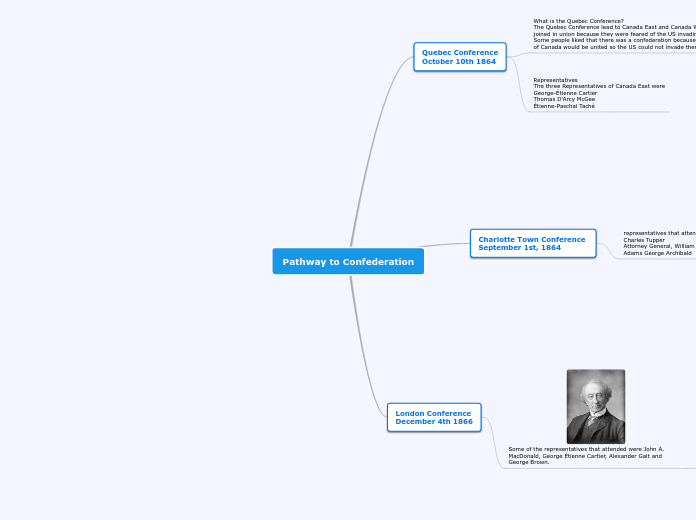Pathway to Confederation
Quebec Conference
October 10th 1864
What is the Quebec Conference?
The Quebec Conference lead to Canada East and Canada West joined in union because they were feared of the US invading. Some people liked that there was a confederation because all of Canada would be united so the US could not invade them.
Different opinions represented
The only opinions that were represented were Canada East, Canada West and the Maritime.
Opinions that were not represented.
Non of the 11 groups of first nations did not have their voice in the conference. The black people also didn't have a voice.
Subtopic
Representatives
The three Representatives of Canada East were
George-Étienne Cartier
Thomas D'Arcy McGee
Étienne-Paschal Taché
Charlotte Town Conference
September 1st, 1864
representatives that attended from Nova Scotia.
Charles Tupper
Attorney General, William Alexander Henry
Adams George Archibald
What was the Point?
Canada refused to pay the costs of the railway because of this the Maritime colonies became a single unit and they hoped that by becoming one unit it would bring strength to the political.
Difference opinions represented
New Brunswick Tilley had always dreamed of a great British North America Nation.
Nova Scotia Tupper and McCully were supporting to unit all of the provinces together. They didn't want to abandon the Maritime Union. There was only one catholic in the meeting who was Andrew Archibald MacDonald
Perspectives that were not represented
some of the middle age men were not in the meeting, there were no women. A big population of people with a different race were also not included in the meeting. There were no delegates spoke for the Irish people. There were no Francophone and the black and the indigenous people were not in public life.
Subtopic
London Conference
December 4th 1866
Some of the representatives that attended were John A. MacDonald, George Étienne Cartier, Alexander Galt and George Brown.
What was the point of the Conference?
The point of conference was to draft the British North America act. They also wanted to review the 72 resolutions that was made in the Quebec Conference. The representatives wanted to name our country the “Kingdom of Canada”. Some of the British feared that by having this name the US would be angry So they named it the “Dominion of Canada”.
Different opinions
The different opinions that were represented were the french, the Roman Catholics.The Roman Catholic bishops were demanding guarantees protecting the separate Catholic schools in this conference.
However, this idea was opposed by the Nova Scotian and New Brunswick representatives.
Perspectives that were not represented
The first nations were not in the conferenceIrish perspectives were not represented
African American perspectives were not represented and In the British North American Act they were not mentioned.
First nations perspectives were not represented. Although act passed at this conference contained things about first nations reserves and land
Terms of agreement
New Brunswick and Nova Scotia changed the 72 resolutions to their won benefits. New Brunswick got assurances that a railway would be built
The provincial government subsidies increased.
some of the 72 resolutions
he General Government and Parliament shall have all powers necessary or proper for performing the obligations of the Federated Provinces, as part of the British Empire, to Foreign Countries arising under Treaties between Great Britain and such Countries was the 30th resolution.
Both the English and French languages may be employed in the General Parliament and in its proceedings, and in the Local Legislature of Lower Canada, and also in the Federal Courts and in the Courts of Lower Canada was the 46th resolution.
In regard to all subjects over which jurisdiction belongs to both the General and Local Legislatures, the laws of the General Parliament shall control and supersede those made by the Local Legislature, and the latter shall be void so far as they are repugnant to, or inconsistent with, the former was the 45th resolution
